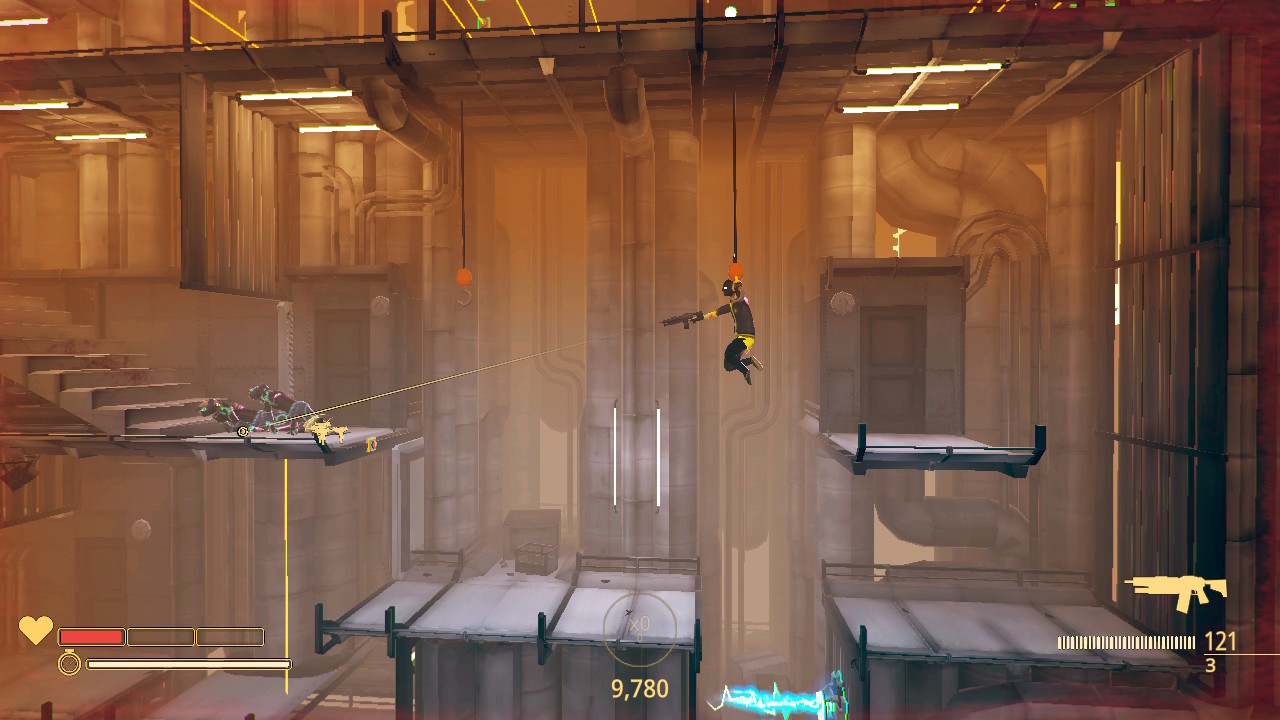
Pedro is the name of the funny, emoji-looking banana that tells the protagonist who to kill, provides little to no reason as to why, and then cracks jokes about the gruesome deaths. The player starts the game as the masked protagonist (who oddly resembles Smoke from Tom Clancy’s Rainbow Six: Siege) with no background on how he got where he is at. The floating banana (Pedro) then tells the protagonist to start killing people, essentially justifying it because they are “bad people”. After you kill the first person, he remarks, “Huh… Well, I guess you’ll just have to kill them all now” and you follow him down the rabbit hole. From time to time, he will provide funny commentary or pop up with emoji-like expressions on the side of the screen based on your experiences and execution. Pedro is not only the mastermind behind the game, but also a tool to keep you, the player, engaged.
As the player, you almost feel guilty as you start killing without fully knowing why, and the story begins to immerse you. In contrast to other shoot ‘em up games that tend to provide a clear reason behind the killings, My Friend Pedro leaves you with a splinter that you may be doing something wrong. Perhaps you should not be killing all these people, but what else can you do when they are coming at you guns blazin’ and the banana does all the talking for you?
Even though My Friend Pedro is a side-scrolling game, its graphics are more immersive in that the camera adjusts as you walk through the stage, creating a sense of depth perception. There are many environmental factors that help draw you into the stage, from lighting to breakable boxes or even kickable objects (like pieces of meat or barrels). Some of the items, like the skillet, give you an advantage by setting up different types of kills, such as the “ricochet kills” in which you kick the skillet into the air, shoot it, and it distributes the bullets to the enemies without you having a direct confrontation. However, from all the features, the fact that you can aim at two different places at once makes this game unique.
There are different types of weapons that you can get throughout the game, and at times, you may dual-wield some of them. If you shoot, both guns will fire in the same direction, but at the press of a button, you can use the analog stick to simultaneously aim at a different part of the screen. One of the arms locks into position, and the other is free to wander. There are other unique features of the game such as slow-motion, bullet-dodging spins, and parkour-looking jumps, but none of those will make you feel as cross-eyed as aiming to two extremities of the screen.
This unique gameplay, in combination with the staging and story, creates a fun game that you’ll likely want to go back to even after you are completely done with it. The dual-wielding and aiming system works, but it is not flawless. After you kill one enemy, your weapon remains locked in the same position. You cannot freely aim with both arms at the same time. You must “reset” the locked arm location and continue shooting.
Most of the time, it is unclear where exactly Pedro will take you, but there are five stages with multiple chapters each. Even though they are only five, each stage features unique and differing scenes per chapter. You wake up in a meat factory with some shady dealings, then Pedro seemingly knocks you out and takes you “where [he] goes when you can’t see [him].” It quickly becomes clear that he is in control of your life. You go wherever he dictates, and nothing is ever the same. The banana takes you from factories to rooftops to buildings to freefalls and even onto a motorcycle. These different stages feature unique challenges, such as laser traps, that help make the game not feel repetitive as you wipe out anyone that gets in your way.
Each unique stage adds to the weapons and environmental items available on your quest for mayhem. Some stages even set up different ways for you to go into the battle with vents, kickable objects, and explosive tanks. They are not always the fastest way to eliminate the threats, but they make for some good cinematic moments.
Shoot ‘em up
For the most part, the battles progressively become more difficult. You start off taking on one person. Afterward, you encounter two, and eventually, the stages set you up to drop in the middle of a group of foes by rolling into air ducts or sliding down dangling hooks. The weapons the enemy uses change from stage to stage. You may first encounter an enemy with a pistol, but later, you may run into several who have automatic weapons or shotguns.

Toward the end, there are different traps you have to dodge, environmental tools you have to make use of, and better weapons you can wield.
In battle, you can duck, jump, bounce off walls, hang from cables, spin (to dodge bullets), and even slow time. If you manage to sneak up to an enemy, you can also kick them. Dodging must be timed, otherwise, the bullets will still hit you. With all this in mind, there are many ways you can proceed through battle, and the different staging of the enemies provide opportunities for badass moves that will have you feeling like John Wick. At times, Pedro may even appear on the side of the screen and give you an expression depending on his level of satisfaction with your performance.
Overall, the game itself is not very difficult. Your health can partially regenerate with time, and the slow-motion gauge also refills. There are a couple of boss fights that correspond to the different stages depending on who oversees the enemies in the greater setting of the stage, but even those are not overly challenging. The real challenge comes in the form of a grading system where your performance earns you a letter grade (A through F). If you want to earn a higher grade, you can replay the same stage and break your own record by getting shot less and adding more flair to your executions. The stages provide unique opportunities and memorable scenarios that make replaying a stage fun and entertaining instead of a repetitive drag.
While the gameplay is enjoyable, the game is not free of flaws. For one, the soundtrack seems lacking. Most stages feature electronica beats, but they are not well-synced with the events of the game. You can be unloading on several enemies, and a calm beat will be playing in the background. It feels like a missed opportunity for an indie game to feature indie artists that could have contributed to the atmosphere of the story. Perhaps on a sequel?
Because My Friend Pedro is a shoot ‘em up, side-scrolling game, one may expect it to have quite a bit of meaningless killing. At first glance, it seems like an arcade game that will get you bored with time. Its mechanics bring a unique approach to action games reminiscent of early 2000s Matrix flash games. However, it is different in that the stages are quite immersive, and the progression of the plot makes it an entertaining and memorable game. Trying to make sense of why you are on this rampage keeps you playing, and unexpected foes will have you feeling sorry for the main lonesome character. The level of difficulty and opportunity for improvement also makes you want to keep replaying through many of the fun stages.
Final Rating: 8/10.